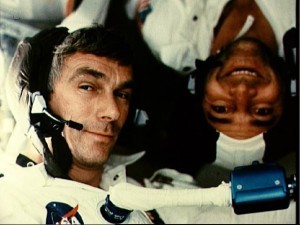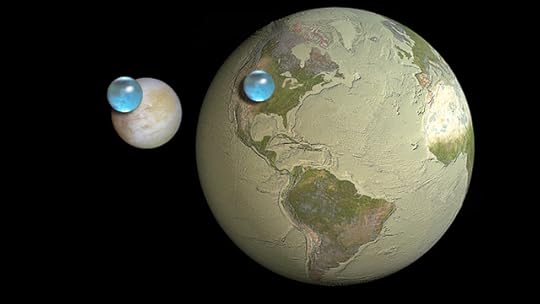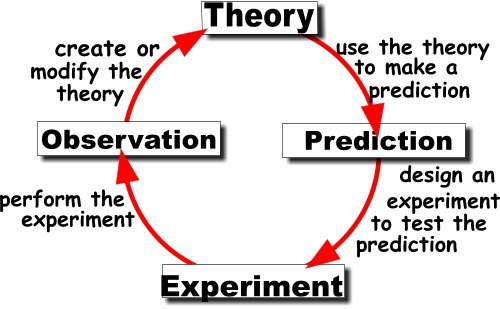Peter Cawdron's Blog, page 18
January 22, 2013
Getting to Mars
Getting to Mars is, quite literally, going to be a case of turning science fiction into science fact.
I thought you’d enjoy looking at one of the suggestions under consideration by NASA for a craft capable of taken humanity to Mars and beyond.
The Nautilus is a true space ship in that, like the International Space Station, it will be built on Earth but assembled into its final form in space. And, like the space station, it can never come back to Earth in one piece. If it ever enters the depths of our atmosphere it will do so in a fiery ball.
Also, like the space station, the Nautilus relies heavily on solar power.
The first things most people notice when looking at the Nautilus is the inflatable side modules, effectively quadrupling the internal usable space within the craft.
Bigelow Aerospace has already demonstrated the effectiveness of inflatable habitats in space, and with the outer skin able to seal itself in the event of a micro-asteroid breach, NASA are looking to trial these on the International Space Station.
 The donut-shaped ring in the midsection is an ingenious idea that’s been around since the 50s in science fiction but one that has never been put into practice in orbit. It’s a spinning, revolving torus that gives the illusion of gravity.
The donut-shaped ring in the midsection is an ingenious idea that’s been around since the 50s in science fiction but one that has never been put into practice in orbit. It’s a spinning, revolving torus that gives the illusion of gravity.
Have you ever seen one of those small, hand-pushed roundabouts in a child’s playground? My kids love them. My kids cheer as I spin them faster and faster, and the conservation of angular momentum gives them the illusion of an outward force, seemingly pushing them to the edge of the roundabout.
In the same way, the spinning torus on the Nautilus will give the sensation of gravity to astronauts. The weightlessness experienced by astronauts in constant free-fall is a serious problem for any mission to Mars.
In space, bone density drops at an alarming rate, giving a forty year old the bone density of a 70-80 year old inside of a year. Muscles atrophy and waste away, which has serious implications for the heart. Bodily fluids redistribute causing havoc for the sinuses, and sleep patterns are disrupted. Space is a tough environment. At least 50% of astronauts end up with space sickness for the first couple of days (similar to sea sickness), so simulating gravity could bring some very real benefits to prolonged space exploration.
The proposal before NASA is to spend just over two years developing a centrifuge torus add-on for the International Space Station to test this concept in a low-earth orbit.
Partial gravity of the torus
Revolutions per minute
30 foot diameter
40 foot diameter
4
0.08
0.11
6
0.18
0.25
8
0.33
0.44
10
0.51
0.69
It may not sound like much, but even at four revolutions per minute, this minuscule simulated gravity would be enough to keen a sleeping astronaut comfortably in one spot. At eight revolutions, the torus would have a similar gravitational “feel” to the Lunar surface, while ten revolutions gets up to half what we experience on Earth.
Here’s an artist’s impression of the ISS centrifuge demo. Note that the torus is also partially constructed out of inflatable materials.
If this project goes ahead, it will give NASA the opportunity to evaluate the viability of a similar torus on a manned/womanned mission to Mars.
In particular, NASA is keen to understand the impact of changing exposure between weightlessness and simulated, partial gravity, looking to understand the physical as well as psychological impact. There are implications for the vascular system, ocular (sight), skeletal and muscular as well as excretory systems (no astronaut would complain about partial gravity when going #1 or #2). One possible downside, though, is scientists expect the transition in and out of the rotating torus may lead to vomiting.
But perhaps the most interesting aspect of the Nautilus design is something the observant reader may have already picked up on in the first image: there’s no engine.
What good is a space ship without an engine?
Actually, this is ingenious. Engines are big. Fuel is massive, that is to say, it takes a lot of fuel to carry fuel. The Nautilus uses a modular engine design, meaning the engine is just another module like those inflatable pods on the side of the craft. The initial configuration of inflatable modules has three pods, but the fuselage could easily be extended to include six, nine, twelve, etc, without adding that much mass proportionally, and the fuel cylinders and engines work much the same way.
The engine is modular, attaching to a plate at the rear of the space craft.
Rather than building the engine into the space craft, NASA can simply bolt on whichever engine is suitable for a particular mission. And in some cases, that may be no engine at all, as in a second space station or small engine when waiting at a gravitationally neutral Lagrange point, like the one between Earth and the Moon.
On some missions, an ion engine might be appropriate, on others a traditional rocket, but, more to the point, this modular design means a mission to Mars can send its return engine and fuel on ahead of itself at a slower pace, saving fuel on the outbound journey.
Using a design like the Nautilus to go to Mars would give our intrepid martian explorers their own space station in orbit while they explore the surface.
The Nautilus is a step in the right direction for developing a spaceship capable of travelling to Mars and beyond. For those that are interested, I’ve attached a presentation that goes into the design in more detail.
Here’s an example of a configuration that could be used on a mission to Mars.


January 17, 2013
The debate is complex
Question: What do the following items have in common?
Refrigerators
Microwave ovens
In-vitro fertilisation
Vaccinations
Washing hands before treating patients
Genetically modified foods
Answer: They were all once feared.
Fridges: Before the advent of the now-banned CFCs a leaking fridge could kill. To this day, people fear silly things about fridges, like the “dangers” of something as harmless as banana skins turning brown. Refrigeration has saved countless otherwise unsuspecting lives from the very real danger of fatal food poisoning.
Microwaves: Microwave ovens, cellphones and WiFi all use electromagnetic radiation and so have been subject to irrational fears about causing cancer.
 Fear, of itself, is not a bad thing as fear is often a catalyst for self-preservation. Stand too close to a snake or the edge of a building and you’ll probably experience a little fear. Move a little closer and your mind will demand you move back, but that’s healthy as another step forward could be disastrous.
Fear, of itself, is not a bad thing as fear is often a catalyst for self-preservation. Stand too close to a snake or the edge of a building and you’ll probably experience a little fear. Move a little closer and your mind will demand you move back, but that’s healthy as another step forward could be disastrous.
When fears become irrational, though, they are extremely damaging. It’s OK to have concerns about a technology like microwave ovens or cellphones or genetically modified foods or whatever, the key is to seek unbiased scientific research to see if that concern is warranted or not.
In the case of the radiation from microwave ovens, cellphones and WiFi there has been considerable research and the findings are unambiguous, they’re perfectly safe.
In-vitro fertilisation: When IVF came out in the 1970s, critics said it was “unnatural,” which is interesting as this position is based on the overly simplistic assumption is that “natural” is always good, therefore “unnatural” is bad. There’s a slight problem with this idea, though, as there’s plenty of “natural” substances that can kill you; cyanide, botulism, the vast majority of mushrooms, etc.
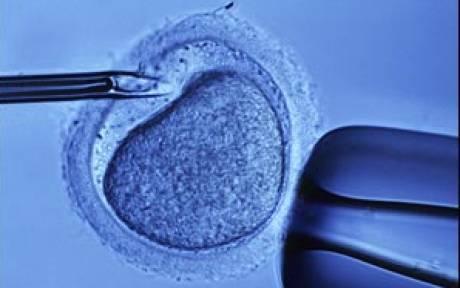 And once you realize how little, real “natural” food there is in the world (ie, food that hasn’t been modified by mankind through selective breeding), you see through this myth quite quickly. Certainly, there is a distinction between processed and unprocessed foods that generally correlates to how healthy foods are, but the term “natural” should be used with caution as it is often misleading.
And once you realize how little, real “natural” food there is in the world (ie, food that hasn’t been modified by mankind through selective breeding), you see through this myth quite quickly. Certainly, there is a distinction between processed and unprocessed foods that generally correlates to how healthy foods are, but the term “natural” should be used with caution as it is often misleading.
When it comes to IVF, critics feared children produced by this “unnatural” means would have horrible birth defects, higher rates of cancer as well as other diseases, and that they would die young. IVF, we were told, would destroy the family as the unit of society. To this day, the Roman Catholic church still considers IVF “morally unacceptable,” which says far more about the Roman Catholic church than it does about IVF.
Vaccinations: Vaccines are wonderful Essentially, vaccines provide target practice for your immune system. By providing weakened or dead forms of a particular microbe, toxin or its proteins the body’s own immune system is taught how to defeat a deadly pathogen before being exposed to the potentially crippling or fatal microbe in the wild.
UNICEF estimates that vaccines save nine million lives every year. Even diseases like measles, that seem petty from our Western perspective, kill over a million children each year. These deaths are entirely preventable through the widespread adoption of vaccination.
 Parents that don’t inoculate their children against these insidious diseases make that choice for sincere but misguided reasons.
Parents that don’t inoculate their children against these insidious diseases make that choice for sincere but misguided reasons.
Fear has been described as False Evidence Appearing Real, and nowhere could that be any more true than in the case of a parent’s fear of vaccines.
Worse still, Muslim extremists recently murdered aid-workers providing life-saving polio vaccinations to children in Pakistan. Stupidity like this is enough to make you wonder which century you’re living in, as such irrational behaviour should have disappeared with the Dark Ages.
Washing hands: As for washing hands, how could that be controversial?
Who could object to such a simple act of hygiene being conducted by doctors and nurses? Well, pretty much the entire medical profession of Europe in the mid 1800s!
When Dr Semmelweis first proposed that disease was spread within hospitals by unclean hands he was ridiculed by the medical establishment. Even after he demonstrated the value of washing hands in slightly-chlorinated water and accurately recorded a massive drop in death rates within his wards, the idea of hand washing was still belittled as unscientific.
Semmelweis came to his conclusion in Europe more than a decade before the American Civil War where 65% of casualties died from infection (primarily due to poor hygiene in field hospitals). More Americans died in the Civil War than in all other wars combined, and yet most of those deaths could have been prevented with the simplest of hygienic measures had the message of Semmelweis been heeded.
Call me paranoid, but hospital hygiene is still a major concern today. The US Dept of Health and Human Services considers hospital infections in the top 10 killers in the US, with upwards of a hundred thousand needless deaths per year. The availability of hand sanitizers in patient rooms/wards should reverse this trend, but recent stats are hard to find.
Anyway, as you can see, the debate is over.
The debate is over in terms of washing hands. The debate is over when it comes to refrigerators, microwaves, vaccinations and IVF. And yet, that’s not the whole story.
Science demands transparency. Science demands honesty. When it comes to science, neither you nor I have the luxury of picking and choosing the results we want.
Yes, the debate is over, but only at the level of general acceptance. When it comes to vaccines and IVF, or even microwaves and fridges, good science continues to examine the evidence. After all, that’s what led to the ban on CFCs that, for half a century, seemed like such a good idea. CFCs were a great idea for mankind, but not for the environment as they damaged the ozone layer, and science exposed that. The same is true when it comes to developing new vaccines or new treatments in IVF. Each of these needs to be tested, but the overall concept is sound.
And so, on one hand, the debate is over. On the other, it’s just beginning. If you like, the subject has changed. Instead of looking to validate these concepts, the debate has shifted to efficacy.
When it comes to genetically modified foods, the debate about the validity of the concept is also over. But that doesn’t mean blind acceptance of GMO, this debate has shifted to one of efficacy and implementation.
Earlier this month, I posted the transcript of a speech by Mark Lynas called “The debate is over,” taking the title from his comments, but really the title should have been “The debate is complex, but proceeding well.”
There’s a danger in over-simplistic statements, and yet there is a need to move beyond the question of accepting GMO to how it can be regulated properly and used in the best interests of not only humanity but nature itself.
Good science is about examining the evidence objectively and without bias. Sounds easy, but more often than not the toughest part of science is found in removing the human element.
One helpful tool in this regard is meta-analysis, that is, the analysis of the scientific analysis of a concept. In other words, watching the watchmen, policing the police.
A recent meta-analysis of breast cancer trials exposed a worrying bias toward whitewashing results.
1/3 of the breast cancer trials under examination did not show a statistically significant outcome for the treatment under investigation but still reported as positive based on secondary benefits, ie. The therapy didn’t increase longevity but patients had less side-effects than those undergoing standard treatments
2/3 of trials reported adverse side-effects but under-reported the extent of these side-effects when the treatment was deemed effective
Over half of the papers focused on other, less important aspects of the trial so as to appear to have a positive outcome
It’s tempting to hear something like this and think the results were massaged because of funding concerns, but the analysis showed this trend occurred for trials conducted by academic institutions and the medical industry.
In those with outcomes that were either negative or did not show a statistically significant benefit, spin was used frequently to influence positively the interpretation of the results
No one likes to fail or look bad. And yet in science null outcomes are entirely acceptable and should be applauded. You can learn as much by observing what doesn’t work as you can by tracking what does, but spin obscures reality, and that’s never good for science.
As these were phase III clinical trials, researches must have felt compelled to find “something” to justify why the trial had advanced through phases I & II, but they should have had the courage to stop the bandwagon.
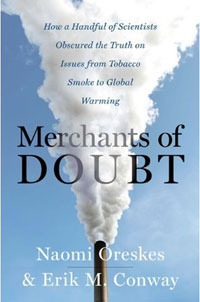 Meta-analysis is an exciting field of research. In essence it looks for trends and patterns in how scientists report their results, looking for inconsistencies and human biases that obscure the real outcome.
Meta-analysis is an exciting field of research. In essence it looks for trends and patterns in how scientists report their results, looking for inconsistencies and human biases that obscure the real outcome.
Naomi Oreskes’ book Merchants of Doubt is a landmark work in this regard, revealing how a handful of dissenting scientists fraudulently undermined the science of climate change, instilling doubt rather than debate.
Oreskes’ meta-analysis revealed disturbing patterns of circular references, things like the Heritage Foundation would cite the Competitive Enterprise Institute who quoted the Marshall Institute, only all three organisations had the same founders and, on close examination, the Marshall Institute was found to be citing the Heritage Foundation to start with, bringing the illusion full circle.
Honesty and transparency are not optional in science.
When it comes to genetically modified foods there’s a need for good science to prevail. Commercial considerations must be secondary to the interests of the planet as a whole, but this is promising technology.
They say, fire is a good servant, a lousy master, and the same is true of genetic engineering. I’d like to see meta-analysis conducted on GMO research, but I’m not afraid of genetic modifications, as we’ve been modifying the genes within our foods for thousands of years.
Perhaps Dr Karl Kruszelnicki’s response to a question about GMO is the best answer of all.


January 7, 2013
Dawn mission to the asteroid belt
In 2007, NASA launched the Dawn mission to explore Ceres and then Vesta in the asteroid belt.
Dawn won’t arrive at Ceres until 2015, but when it does it will have the opportunity to examine a proto-planet, that is a planetary body in its infancy. The asteroid belt, which is located between Mars and Jupiter, is thought to be the remains of the initial disc that formed the planets within our solar system billions of years ago. Ordinarily, these asteroids would have slowly accumulated into a planet like Mars, Earth or Venus, but the thinking is that Jupiter’s gravitational presence has kept this from happening by drawing off most of the mass, and this gives us a glimpse into the remote past, the opportunity to understand more about how our own planet once formed.
Perhaps the most remarkable aspect of this mission, though, is the use of an ion propulsion engine.
 Hold a single sheet of printer paper in your hand and feel the minuscule sense of weight pressing down on your fingertips. It’s hard to imagine how an engine producing this little force against a spacecraft could ever be considered viable, but the ion engine is not only viable, it has set the speed record for interplanetary spacecraft.
Hold a single sheet of printer paper in your hand and feel the minuscule sense of weight pressing down on your fingertips. It’s hard to imagine how an engine producing this little force against a spacecraft could ever be considered viable, but the ion engine is not only viable, it has set the speed record for interplanetary spacecraft.
Ion engines may sound like some exotic, futuristic alternative to the chemical rockets we’re so familiar with, but the concept was first experimented with in 1916, during the First World War. On Earth, ion engines are little more than a novelty. In space, where they can operate without wind resistance, they are the undisputed champions of travel, but you have to be patient.
Like a bank account earning interest over fifty years, the law of compounding effects allows the ion engine to slowly but surely continue gathering momentum and reach astonishing speeds.
It took Dawn four days to accelerate to 60 miles per hour, but over six years, that constant steady push, never more than the weight of paper in your hand, has resulted in an accumulated acceleration of 9,600mph. The craft’s total change in velocity since it left Earth is over 38,000 miles per hour, and, what’s more, it’s done this using less fuel than you find in most semi-trucks. Dawn uses xenon, not diesel, but it’s only carrying roughly 115 gallons (937 pounds to be precise).
So think about the Dawn mission the next time you see a semi driving by or pick up some paper from the printer. Small efficient engines can go a long way.


January 3, 2013
The debate is over
 If you’re concerned about genetically modified foods, you probably have Mark Lynas to thank.
If you’re concerned about genetically modified foods, you probably have Mark Lynas to thank.
From the mid-90s until as late as 2008, Mark Lynas was an environmental activist and vocal opponent of genetically modified crops, but to his credit, he’s swallowed his pride and looked at the evidence objectively.
In this speech from the 2013 Oxford Farming Convention, Mark outlines the scientific and rational logic supporting GM foods.
Genetically modified foods can seem a little scary, especially given all the hype from activist groups, but the reality is, we’ve been genetically modifying foods for thousands of years. Only, up until now, our means of modifying crops and animals has been clumsy and haphazard, as the result of trial and error with selective breeding. Now, we have the technology to be precise and target specific traits. Not only does this have profound implications for public health, it has a significant, positive environmental impact as well.
Here’s Mark’s speech. It’s quite long, but well worth reading in full.
~~~
I want to start with some apologies. For the record, here and upfront, I apologise for having spent several years ripping up GM crops. I am also sorry that I helped to start the anti-GM movement back in the mid 1990s, and that I thereby assisted in demonising an important technological option which can be used to benefit the environment.
As an environmentalist, and someone who believes that everyone in this world has a right to a healthy and nutritious diet of their choosing, I could not have chosen a more counter-productive path. I now regret it completely.
So I guess you’ll be wondering – what happened between 1995 and now that made me not only change my mind but come here and admit it? Well, the answer is fairly simple: I discovered science, and in the process I hope I became a better environmentalist.
When I first heard about Monsanto’s GM soya I knew exactly what I thought. Here was a big American corporation with a nasty track record, putting something new and experimental into our food without telling us. Mixing genes between species seemed to be about as unnatural as you can get – here was humankind acquiring too much technological power; something was bound to go horribly wrong. These genes would spread like some kind of living pollution. It was the stuff of nightmares.
These fears spread like wildfire, and within a few years GM was essentially banned in Europe, and our worries were exported by NGOs like Greenpeace and Friends of the Earth to Africa, India and the rest of Asia, where GM is still banned today. This was the most successful campaign I have ever been involved with.
This was also explicitly an anti-science movement. We employed a lot of imagery about scientists in their labs cackling demonically as they tinkered with the very building blocks of life. Hence the Frankenstein food tag – this absolutely was about deep-seated fears of scientific powers being used secretly for unnatural ends. What we didn’t realise at the time was that the real Frankenstein’s monster was not GM technology, but our reaction against it.
For me this anti-science environmentalism became increasingly inconsistent with my pro-science environmentalism with regard to climate change. I published my first book on global warming in 2004, and I was determined to make it scientifically credible rather than just a collection of anecdotes.
So I had to back up the story of my trip to Alaska with satellite data on sea ice, and I had to justify my pictures of disappearing glaciers in the Andes with long-term records of mass balance of mountain glaciers. That meant I had to learn how to read scientific papers, understand basic statistics and become literate in very different fields from oceanography to paleoclimate, none of which my degree in politics and modern history helped me with a great deal.
I found myself arguing constantly with people who I considered to be incorrigibly anti-science, because they wouldn’t listen to the climatologists and denied the scientific reality of climate change. So I lectured them about the value of peer-review, about the importance of scientific consensus and how the only facts that mattered were the ones published in the most distinguished scholarly journals.
My second climate book, Six Degrees, was so sciency that it even won the Royal Society science books prize, and climate scientists I had become friendly with would joke that I knew more about the subject than them. And yet, incredibly, at this time in 2008 I was still penning screeds in the Guardian attacking the science of GM – even though I had done no academic research on the topic, and had a pretty limited personal understanding. I don’t think I’d ever read a peer-reviewed paper on biotechnology or plant science even at this late stage.
Obviously this contradiction was untenable. What really threw me were some of the comments underneath my final anti-GM Guardian article. In particular one critic said to me: so you’re opposed to GM on the basis that it is marketed by big corporations. Are you also opposed to the wheel because because it is marketed by the big auto companies?
So I did some reading. And I discovered that one by one my cherished beliefs about GM turned out to be little more than green urban myths.
I’d assumed that it would increase the use of chemicals. It turned out that pest-resistant cotton and maize needed less insecticide.
I’d assumed that GM benefited only the big companies. It turned out that billions of dollars of benefits were accruing to farmers needing fewer inputs.
I’d assumed that Terminator Technology was robbing farmers of the right to save seed. It turned out that hybrids did that long ago, and that Terminator never happened.
I’d assumed that no-one wanted GM. Actually what happened was that Bt cotton was pirated into India and roundup ready soya into Brazil because farmers were so eager to use them.
I’d assumed that GM was dangerous. It turned out that it was safer and more precise than conventional breeding using mutagenesis for example; GM just moves a couple of genes, whereas conventional breeding mucks about with the entire genome in a trial and error way.
But what about mixing genes between unrelated species? The fish and the tomato? Turns out viruses do that all the time, as do plants and insects and even us – it’s called gene flow.
But this was still only the beginning. So in my third book The God Species I junked all the environmentalist orthodoxy at the outset and tried to look at the bigger picture on a planetary scale.
And this is the challenge that faces us today: we are going to have to feed 9.5 billion hopefully much less poor people by 2050 on about the same land area as we use today, using limited fertiliser, water and pesticides and in the context of a rapidly-changing climate.
Let’s unpack this a bit. I know in a previous year’s lecture in this conference there was the topic of population growth. This area too is beset by myths. People think that high rates of fertility in the developing world are the big issue – in other words, poor people are having too many children, and we therefore need either family planning or even something drastic like mass one-child policies.
The reality is that global average fertility is down to about 2.5 – and if you consider that natural replacement is 2.2, this figure is not much above that. So where is the massive population growth coming from? It is coming because of declining infant mortality – more of today’s youngsters are growing up to have their own children rather than dying of preventable diseases in early childhood.
The rapid decline in infant mortality rates is one of the best news stories of our decade and the heartland of this great success story is sub-Saharan Africa. It’s not that there are legions more children being born – in fact, in the words of Hans Rosling, we are already at ‘peak child’. That is, about 2 billion children are alive today, and there will never be more than that because of declining fertility.
But so many more of these 2 billion children will survive into adulthood today to have their own children. They are the parents of the young adults of 2050. That’s the source of the 9.5 billion population projection for 2050. You don’t have to have lost a child, God forbid, or even be a parent, to know that declining infant mortality is a good thing.
So how much food will all these people need? According to the latest projections, published last year in the Proceedings of the National Academy of Sciences, we are looking at a global demand increase of well over 100% by mid-century. This is almost entirely down to GDP growth, especially in developing countries.
In other words, we need to produce more food not just to keep up with population but because poverty is gradually being eradicated, along with the widespread malnutrition that still today means close to 800 million people go to bed hungry each night. And I would challenge anyone in a rich country to say that this GDP growth in poor countries is a bad thing.
But as a result of this growth we have very serious environmental challenges to tackle. Land conversion is a large source of greenhouse gases, and perhaps the greatest source of biodiversity loss. This is another reason why intensification is essential – we have to grow more on limited land in order to save the rainforests and remaining natural habitats from the plough.
We also have to deal with limited water – not just depleting aquifers but also droughts that are expected to strike with increasing intensity in the agricultural heartlands of continents thanks to climate change. If we take more water from rivers we accelerate biodiversity loss in these fragile habitats.
We also need to better manage nitrogen use: artificial fertiliser is essential to feed humanity, but its inefficient use means dead zones in the Gulf of Mexico and many coastal areas around the world, as well as eutrophication in fresh water ecosystems.
It is not enough to sit back and hope that technological innovation will solve our problems. We have to be much more activist and strategic than that. We have to ensure that technological innovation moves much more rapidly, and in the right direction for those who most need it.
In a sense we’ve been here before. When Paul Ehrlich published the Population Bomb in 1968, he wrote: “The battle to feed all of humanity is over. In the 1970s hundreds of millions of people will starve to death in spite of any crash programs embarked upon now.” The advice was explicit – in basket-case countries like India, people might as well starve sooner rather than later, and therefore food aid to them should be eliminated to reduce population growth.
It was not pre-ordained that Ehrlich would be wrong. In fact, if everyone had heeded his advice hundreds of millions of people might well have died needlessly. But in the event, malnutrition was cut dramatically, and India became food self-sufficient, thanks to Norman Borlaug and his Green Revolution.
It is important to recall that Borlaug was equally as worried about population growth as Ehrlich. He just thought it was worth trying to do something about it. He was a pragmatist because he believed in doing what was possible, but he was also an idealist because he believed that people everywhere deserved to have enough to eat.
So what did Norman Borlaug do? He turned to science and technology. Humans are a tool-making species – from clothes to ploughs, technology is primarily what distinguishes us from other apes. And much of this work was focused on the genome of major domesticated crops – if wheat, for example, could be shorter and put more effort into seed-making rather than stalks, then yields would improve and grain loss due to lodging would be minimised.
Before Borlaug died in 2009 he spent many years campaigning against those who for political and ideological reasons oppose modern innovation in agriculture. To quote: “If the naysayers do manage to stop agricultural biotechnology, they might actually precipitate the famines and the crisis of global biodiversity they have been predicting for nearly 40 years.”
And, thanks to supposedly environmental campaigns spread from affluent countries, we are perilously close to this position now. Biotechnology has not been stopped, but it has been made prohibitively expensive to all but the very biggest corporations.
It now costs tens of millions to get a crop through the regulatory systems in different countries. In fact the latest figures I’ve just seen from CropLife suggest it costs $139 million to move from discovering a new crop trait to full commercialisation, so open-source or public sector biotech really does not stand a chance.
There is a depressing irony here that the anti-biotech campaigners complain about GM crops only being marketed by big corporations when this is a situation they have done more than anyone to help bring about.
In the EU the system is at a standstill, and many GM crops have been waiting a decade or more for approval but are permanently held up by the twisted domestic politics of anti-biotech countries like France and Austria. Around the whole world the regulatory delay has increased to more than 5 and a half years now, from 3.7 years back in 2002. The bureaucratic burden is getting worse.
France, remember, long refused to accept the potato because it was an American import. As one commentator put it recently, Europe is on the verge of becoming a food museum. We well-fed consumers are blinded by romantic nostalgia for the traditional farming of the past. Because we have enough to eat, we can afford to indulge our aesthetic illusions.
But at the same time the growth of yields worldwide has stagnated for many major food crops, as research published only last month by Jonathan Foley and others in the journalNature Communications showed. If we don’t get yield growth back on track we are indeed going to have trouble keeping up with population growth and resulting demand, and prices will rise as well as more land being converted from nature to agriculture.
To quote Norman Borlaug again: “I now say that the world has the technology — either available or well advanced in the research pipeline — to feed on a sustainable basis a population of 10 billion people. The more pertinent question today is whether farmers and ranchers will be permitted to use this new technology? While the affluent nations can certainly afford to adopt ultra low-risk positions, and pay more for food produced by the so-called ‘organic’ methods, the one billion chronically undernourished people of the low income, food-deficit nations cannot.”
As Borlaug was saying, perhaps the most pernicious myth of all is that organic production is better, either for people or the environment. The idea that it is healthier has been repeatedly disproved in the scientific literature. We also know from many studies that organic is much less productive, with up to 40-50% lower yields in terms of land area. The Soil Association went to great lengths in a recent report on feeding the world with organic not to mention this productivity gap.
Nor did it mention that overall, if you take into account land displacement effects, organic is also likely worse for biodiversity. Instead they talk about an ideal world where people in the west eat less meat and fewer calories overall so that people in developing countries can have more. This is simplistic nonsense.
If you think about it, the organic movement is at its heart a rejectionist one. It doesn’t accept many modern technologies on principle. Like the Amish in Pennsylvania, who froze their technology with the horse and cart in 1850, the organic movement essentially freezes its technology in somewhere around 1950, and for no better reason
It doesn’t even apply this idea consistently however. I was reading in a recent Soil Association magazine that it is OK to blast weeds with flamethrowers or fry them with electric currents, but benign herbicides like glyphosate are still a no-no because they are ‘artificial chemicals’.
In reality there is no reason at all why avoiding chemicals should be better for the environment – quite the opposite in fact. Recent research by Jesse Ausubel and colleagues at Rockefeller University looked at how much extra farmland Indian farmers would have had to cultivate today using the technologies of 1961 to get today’s overall yield. The answer is 65 million hectares, an area the size of France.
In China, maize farmers spared 120 million hectares, an area twice the size of France, thanks to modern technologies getting higher yields. On a global scale, between 1961 and 2010 the area farmed grew by only 12%, whilst kilocalories per person rose from 2200 to 2800. So even with three billion more people, everyone still had more to eat thanks to a production increase of 300% in the same period.
So how much land worldwide was spared in the process thanks to these dramatic yield improvements, for which chemical inputs played a crucial role? The answer is 3 billion hectares, or the equivalent of two South Americas. There would have been no Amazon rainforest left today without this improvement in yields. Nor would there be any tigers in India or orang utans in Indonesia. That is why I don’t know why so many of those opposing the use of technology in agriculture call themselves environmentalists.
So where does this opposition come from? There seems to be a widespread assumption that modern technology equals more risk. Actually there are many very natural and organic ways to face illness and early death, as the debacle with Germany’s organic beansprouts proved in 2011. This was a public health catastrophe, with the same number of deaths and injuries as were caused by Chernobyl, because E.-coli probably from animal manure infected organic beansprout seeds imported from Egypt.
In total 53 people died and 3,500 suffered serious kidney failure. And why were these consumers choosing organic? Because they thought it was safer and healthier, and they were more scared of entirely trivial risks from highly-regulated chemical pesticides and fertilisers.
If you look at the situation without prejudice, much of the debate, both in terms of anti-biotech and organic, is simply based on the naturalistic fallacy – the belief that natural is good, and artificial is bad. This is a fallacy because there are plenty of entirely natural poisons and ways to die, as the relatives of those who died from E.-coli poisoning would tell you.
For organic, the naturalistic fallacy is elevated into the central guiding principle for an entire movement. This is irrational and we owe it to the Earth and to our children to do better.
This is not to say that organic farming has nothing to offer – there are many good techniques which have been developed, such as intercropping and companion planting, which can be environmentally very effective, even it they do tend to be highly labour-intensive. Principles of agro-ecology such as recyling nutrients and promoting on-farm diversity should also be taken more seriously everywhere.
But organic is in the way of progress when it refuses to allow innovation. Again using GM as the most obvious example, many third-generation GM crops allow us not to use environmentally-damaging chemicals because the genome of the crop in question has been altered so the plant can protect itself from pests. Why is that not organic?
Organic is also in the way when it is used to take away choice from others. One of the commonest arguments against GM is that organic farmers will be ‘contaminated’ with GM pollen, and therefore no-one should be allowed to use it. So the rights of a well-heeled minority, which come down ultimately to a consumer preference based on aesthetics, trump the rights of everyone else to use improved crops which would benefit the environment.
I am all for a world of diversity, but that means one farming system cannot claim to have a monopoly of virtue and aim at excluding all other options. Why can’t we have peaceful co-existence? This is particularly the case when it shackles us to old technologies which have higher inherent risks than the new.
It seems like almost everyone has to pay homage to ‘organic’ and to question this orthodoxy is unthinkable. Well I am here to question it today.
The biggest risk of all is that we do not take advantage of all sorts of opportunities for innovation because of what is in reality little more than blind prejudice. Let me give you two examples, both regrettably involving Greenpeace.
Last year Greenpeace destroyed a GM wheat crop in Australia, for all the traditional reasons, which I am very familiar with having done it myself. This was publicly funded research carried out by the Commonwealth Scientific Research institute, but no matter. They were against it because it was GM and unnatural.
What few people have since heard is that one of the other trials being undertaken, which Greenpeace activists with their strimmers luckily did not manage to destroy, accidentally found a wheat yield increase of an extraordinary 30%. Just think. This knowledge might never have been produced at all, if Greenpeace had succeeded in destroying this innovation. As the president of the NFU Peter Kendall recently suggeseted, this is analogous to burning books in a library before anyone has been able to read them.
The second example comes from China, where Greenpeace managed to trigger a national media panic by claiming that two dozen children had been used as human guinea pigs in a trial of GM golden rice. They gave no consideration to the fact that this rice is healthier, and could save thousands of children from vitamin A deficiency-related blindness and death each year.
What happened was that the three Chinese scientists named in the Greenpeace press release were publicly hounded and have since lost their jobs, and in an autocratic country like China they are at serious personal risk. Internationally because of over-regulation golden rice has already been on the shelf for over a decade, and thanks to the activities of groups like Greenpeace it may never become available to vitamin-deficient poor people.
This to my mind is immoral and inhumane, depriving the needy of something that would help them and their children because of the aesthetic preferences of rich people far away who are in no danger from Vitamin A shortage. Greenpeace is a $100-million a year multinational, and as such it has moral responsibilities just like any other large company.
The fact that golden rice was developed in the public sector and for public benefit cuts no ice with the antis. Take Rothamsted Research, whose director Maurice Moloney is speaking tomorrow. Last year Rothamsted began a trial of an aphid-resistant GM wheat which would need no pesticides to combat this serious pest.
Because it is GM the antis were determined to destroy it. They failed because of the courage of Professor John Pickett and his team, who took to YouTube and the media to tell the important story of why their research mattered and why it should not be trashed. They gathered thousands of signatures on a petition when the antis could only manage a couple of hundred, and the attempted destruction was a damp squib.
One intruder did manage to scale the fence, however, who turned out to be the perfect stereotypical anti-GM protestor – an old Etonian aristocrat whose colourful past makes our Oxford local Marquess of Blandford look like the model of responsible citizenry.
This high-born activist scattered organic wheat seeds around the trial site in what was presumably a symbolic statement of naturalness. Professor Pickett’s team tell me they had a very low-tech solution to getting rid of it – they went round with a cordless portable hoover to clear it up.
This year, as well as repeating the wheat trial, Rothamsted is working on an omega 3 oilseed that could replace wild fish in food for farmed salmon. So this could help reduce overfishing by allowing land-based feedstocks to be used in aquaculture. Yes it’s GM, so expect the antis to oppose this one too, despite the obvious potential environmental benefits in terms of marine biodiversity.
I don’t know about you, but I’ve had enough. So my conclusion here today is very clear: the GM debate is over. It is finished. We no longer need to discuss whether or not it is safe – over a decade and a half with three trillion GM meals eaten there has never been a single substantiated case of harm. You are more likely to get hit by an asteroid than to get hurt by GM food. More to the point, people have died from choosing organic, but no-one has died from eating GM.
Just as I did 10 years ago, Greenpeace and the Soil Association claim to be guided by consensus science, as on climate change. Yet on GM there is a rock-solid scientific consensus, backed by the American Association for the Advancement of Science, the Royal Society, health institutes and national science academies around the world. Yet this inconvenient truth is ignored because it conflicts with their ideology.
One final example is the sad story of the GM blight-resistant potato. This was being developed by both the Sainsbury Lab and Teagasc, a publicly-funded institute in Ireland – but the Irish Green Party, whose leader often attends this very conference, was so opposed that they even took out a court case against it.
This is despite the fact that the blight-resistant potato would save farmers from doing 15 fungicide sprays per season, that pollen transfer is not an issue because potatoes are clonally propagated and that the offending gene came from a wild relative of the potato.
There would have been a nice historical resonance to having a blight-resistant potato developed in Ireland, given the million or more who died due to the potato famine in the mid 19th century. It would have been a wonderful thing for Ireland to be the country that defeated blight. But thanks to the Irish Green Party, this is not to be.
And unfortunately the antis now have the bureaucrats on their side. Wales and Scotland are officially GM free, taking medieval superstition as a strategic imperative for devolved governments supposedly guided by science.
It is unfortunately much the same in much of Africa and Asia. India has rejected Bt brinjal, even though it would reduce insecticide applications in the field, and residues on the fruit. The government in India is increasingly in thrall to backward-looking ideologues like Vandana Shiva, who idealise pre-industrial village agriculture despite the historical fact that it was an age of repeated famines and structural insecurity.
In Africa, ‘no GM’ is still the motto for many governments. Kenya for example has actually banned GM foods because of the supposed “health risks” despite the fact that they could help reduce the malnutrition that is still rampant in the country – and malnutrition is by the way a proven health risk, with no further evidence needed. In Kenya if you develop a GM crop which has better nutrition or a higher yield to help poorer farmers then you will go to jail for 10 years.
Thus desperately-needed agricultural innovation is being strangled by a suffocating avalanche of regulations which are not based on any rational scientific assessment of risk. The risk today is not that anyone will be harmed by GM food, but that millions will be harmed by not having enough food, because a vocal minority of people in rich countries want their meals to be what they consider natural.
I hope now things are changing. The wonderful Bill and Melinda Gates foundation recently gave $10 million to the John Innes Centre to begin efforts to integrate nitrogen fixing capabilities into major food crops, starting with maize. Yes, Greenpeace, this will be GM. Get over it. If we are going to reduce the global-scale problem of nitrogen pollution then having major crop plants fixing their own nitrogen is a worthy goal.
I know it is politically incorrect to say all this, but we need a a major dose of both international myth-busting and de-regulation. The plant scientists I know hold their heads in their hands when I talk about this with them because governments and so many people have got their sense of risk so utterly wrong, and are foreclosing a vitally necessary technology.
Norman Borlaug is dead now, but I think we honour his memory and his vision when we refuse to give in to politically correct orthodoxies when we know they are incorrect. The stakes are high. If we continue to get this wrong, the life prospects of billions of people will be harmed.
So I challenge all of you today to question your beliefs in this area and to see whether they stand up to rational examination. Always ask for evidence, as the campaigning group Sense About Science advises, and make sure you go beyond the self-referential reports of campaigning NGOs.
But most important of all, farmers should be free to choose what kind of technologies they want to adopt. If you think the old ways are the best, that’s fine. You have that right.
What you don’t have the right to do is to stand in the way of others who hope and strive for ways of doing things differently, and hopefully better. Farmers who understand the pressures of a growing population and a warming world. Who understand that yields per hectare are the most important environmental metric. And who understand that technology never stops developing, and that even the fridge and the humble potato were new and scary once.
So my message to the anti-GM lobby, from the ranks of the British aristocrats and celebrity chefs to the US foodies to the peasant groups of India is this. You are entitled to your views. But you must know by now that they are not supported by science. We are coming to a crunch point, and for the sake of both people and the planet, now is the time for you to get out of the way and let the rest of us get on with feeding the world sustainably.
Thankyou.


December 31, 2012
Scientific Highlights
Science advances at an astonishing rate. In the past year, there have been a number of scientific advances that have turned science fiction into science fact. For most of us, these discoveries flutter by as little more than curiosities. They’re fascinating headlines on a website or in a newspaper, but each of these has significant implications that have the potential to reshape our world over the next decade or so.
Here’s some of the highlights from 2012.
15: Voyager leaves the solar system
 In 1977, the original Star Wars was produced using miniature models for special effects. Star Wars contains a few embarrassingly archaic shots of computer graphics from that era; chunky yellow/green lines plastered on a black screen highlight just how far computing has come in the last thirty five years.
In 1977, the original Star Wars was produced using miniature models for special effects. Star Wars contains a few embarrassingly archaic shots of computer graphics from that era; chunky yellow/green lines plastered on a black screen highlight just how far computing has come in the last thirty five years.
At the same time Star Wars hit the silver screen, NASA launched two Voyager spacecraft on a grand tour of the solar system, providing humanity with its first fleeting glimpse of the gas giants up close. Voyager represents the most audacious expedition in the history of exploration, pushing the then known-technology to its very limits.
 Over the next decade, the two Voyager spacecraft flew by Jupiter, Saturn, Neptune, Uranus and Pluto. In 2012, some thirty five years after it left Earth, Voyager I finally reached the heliosheath, the boundary where particles streaming out from the sun are pushed back by interstellar space.
Over the next decade, the two Voyager spacecraft flew by Jupiter, Saturn, Neptune, Uranus and Pluto. In 2012, some thirty five years after it left Earth, Voyager I finally reached the heliosheath, the boundary where particles streaming out from the sun are pushed back by interstellar space.
If we equated interstellar space to the sea, then Voyager just crossed the river mouth, crossing the bar as it were into open ocean.
 In the same way as a running tap pushes back water in the bottom of your sink, forming a pressure boundary against the rest of the water, the heliosheath represents the boundary between particles moving out from the sun and the general miasma of particles bouncing around in interstellar space.
In the same way as a running tap pushes back water in the bottom of your sink, forming a pressure boundary against the rest of the water, the heliosheath represents the boundary between particles moving out from the sun and the general miasma of particles bouncing around in interstellar space.
Voyager has left the neighbourhood for good.
When you consider that for the past thirty-five years Voyager has been moving at 38,500 mph (over 60,000 kph or more than 16 kilometers a second) you get a sense of just how vast our solar system is, and we orbit just one star among an estimated two hundred billion in the Milky Way galaxy.
14: Curiosity lands on Mars
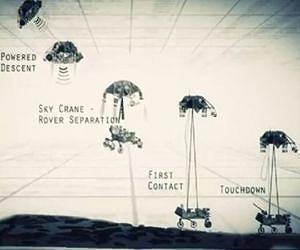 Early this year, NASA described the landing of Curiosity as seven minutes of terror, and they weren’t kidding.
Early this year, NASA described the landing of Curiosity as seven minutes of terror, and they weren’t kidding.
If Voyager is the most audacious exploration ever undertaken, Curiosity is the most audacious and complex planetary landing ever attempted.
Make no mistake about it, hurtling almost four tons of scientific equipment at Mars is like hitting a golfball from Los Angeles to New York and hitting a specific, predefined window on the Empire State building.
Slowing that golfball from over 13,000 mph (or 20,000 kph) to a walking pace in just seven minutes is extraordinary. It’s akin to ensuring that golfball lands gently on the window ledge rather than the breaking glass.
Mars Curiosity is a scientific laboratory on another planet. If life has ever existed on the red planet, Curiosity will reveal its presence.
13: Artificial leaf generates hydrogen
 Problems like climate change aren’t going to be solved by conventional means. With the rapid urbanisation of China and India, we need to curb emissions globally, but even that’s just treating the symptoms.
Problems like climate change aren’t going to be solved by conventional means. With the rapid urbanisation of China and India, we need to curb emissions globally, but even that’s just treating the symptoms.
Cutting emissions may contain the problem and yet it fails to address the cause. There has to be a paradigm shift in how we gather and use energy, and that’s where Daniel Nocera enters the discussion.
Using relatively inexpensive materials, Nocera has developed the world’s first practical artificial leaf. It’s early days, but drop his “leaf” in a jar of water, leave it in the sunlight, and you’ll gather hydrogen and oxygen as byproducts.
12: Flexible, inexpensive solar-panels challenge fossil fuels
 Using an ion-cannon to produce cheap solar-panels definitely sounds like something out of a science fiction movie, but that’s exactly what a US start-up has done.
Using an ion-cannon to produce cheap solar-panels definitely sounds like something out of a science fiction movie, but that’s exactly what a US start-up has done.
With wafers as thin as 3mm, there’s an astounding array of possibilities for innovation with these new solar panels. There’s also the chance for solar power to make significant in-roads as an alternative to fossil fuels.
What’s more, even with the cheap manufacturing costs of current solar panels in China, these cells are half the price of anything on the market. Watch this space! This is a technology that will grow over the next few years.
11: Ultra-flexible “willow” glass allows for curved electronics
 US manufacturing company Corning, who developed the super-tough, lightweight Gorilla Glass found in smartphones, have developed Willow Glass, a flexible glass 0.05mm in thickness that, along with advances in batteries and the use of graphene in electronics, could trigger yet another transformation in computing.
US manufacturing company Corning, who developed the super-tough, lightweight Gorilla Glass found in smartphones, have developed Willow Glass, a flexible glass 0.05mm in thickness that, along with advances in batteries and the use of graphene in electronics, could trigger yet another transformation in computing.
Several years ago, Sony showcased a purely theoretical concept called the wearable personal computer. Imagine your smartphone as a bracelet and you’ll get what they were proposing.
With the ubiquity of Android phones and iPhones, along with their escalating processing power year on year, the Information Age is set to transform society in the same way as the Industrial Revolution. It might take a few years, but computers will literally be at your fingertips day and night.
10: Planet with four suns
As fascinating as this discovery is, you’re probably wondering why it’s rated as high as it is, and it’s not because of the discovery itself, as remarkable as that is, it is how this astonishing planet was discovered that’s really important. This surprising discovery was made by some average Joes participating in citizen science.
 Citizen science is an exciting emerging field, allowing everyday people to contribute to genuine scientific research efforts.
Citizen science is an exciting emerging field, allowing everyday people to contribute to genuine scientific research efforts.
One of the spinoffs of the Information Age is that there’s soooo much information available most research centres need an army of scientists to review and process that information before they can make sense of it.
Enter citizen science. In a carefully controlled manner, scientists can enlist the help of regular citizens to crunch through mountains of data, and the results are as sensational as, well, a planet orbiting four stars.
You can get involved in everything from cancer research to space exploration, from analysing whale calls to tracking climate change over the past fifty years. You can catalog wildlife on the African Serengeti and assist in transcribing ancient manuscripts. It takes a little learning and some attention to detail, but you can participate in some of the most exciting scientific research being undertaken today. You could discover intelligent extraterrestrial life in space, you really could.
Getting back to our planet orbiting four suns, this remarkable planet is about the size of Neptune and has a stable orbit around a binary star system (two stars that closely orbit each other), only these stars in turn orbit another binary star system. Why this planet has not been torn apart, sucked into one of the stars or spun off into space is something scientists are now examining.
9: DARPA “terminator” traverses obstacle course with ease
Arnold said he’d be back, and he wasn’t kidding. Thanks to US military research, Skynet is a live and well and getting ready to come to a battlefield near you.
DARPA, the Defense Advanced Research Projects Agency, has developed a robot that can negotiate obstacles such as a low wall and holes in the ground, using autonomous navigation. Teaching robots to independently navigate a battlefield brings up visions of Terminator-style robots replacing front-line troops. In practice, any such innovation is at least a decade away, but it’s coming.
Think that’s pretty cool? How about a robotic horse that can follow soldiers into battle, carrying their equipment for them? Or, better yet, robotic dogs that can outrun a cheetah?
Clearly, this kind of robotic innovation could never have any horrible side effects.
8: 3-D printer builds a two-story house in a single run
 OK, so the house looks like something from the fictional planet Tatooine, with load-bearing arcs and curves, but it takes a quarter of the time needed to build an equivalent-sized home. And being made from sand and a chemical binder it has the durability of cement. Give it a polish and this printed house comes up looking like marble. It’s cheaper and quicker to build than a conventional home.
OK, so the house looks like something from the fictional planet Tatooine, with load-bearing arcs and curves, but it takes a quarter of the time needed to build an equivalent-sized home. And being made from sand and a chemical binder it has the durability of cement. Give it a polish and this printed house comes up looking like marble. It’s cheaper and quicker to build than a conventional home.
Construction includes a second floor, stairs, internal walls, support columns, domes and wall cavities for piping and electrical wiring.
Once this technology comes of age, it could provide significant assistance in disaster relief as well as in Third World countries, not to mention all the Trekkies wanting a space-age, futuristic home with great ventilation.
7: Human robotics/bionics
 There have been several wonderful advancements in bionics, the use of technology to overcome physical disabilities.
There have been several wonderful advancements in bionics, the use of technology to overcome physical disabilities.
In England, two men have been fitted with light-sensitive microchips that replicate the neural signals for sight, giving them the ability to distinguish black from white as well as to make out the shape of various objects.
Doctors are hopeful their minds can be trained to detect more and more detail over time with their new sight. With twenty thousand people in the UK affected by blinding effects of retinitis pigmentosa, this is a significant medical advance.
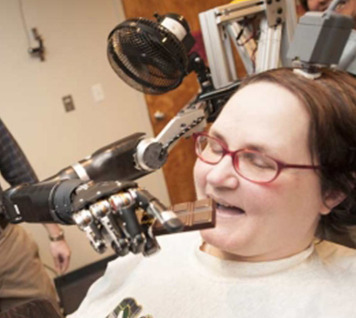 In another Six Million Dollar Man bionic development, a quadriplegic woman, Jan Scheuermann, has learned to control a robotic arm and hand with her thoughts.
In another Six Million Dollar Man bionic development, a quadriplegic woman, Jan Scheuermann, has learned to control a robotic arm and hand with her thoughts.
Although there have been similar advances over the past decade, Jan has achieved a level of speed and dexterity that approaches that of an able-bodied person.
For those with spinal cord injuries or motor neuron disease this represents the possibility of renewed independence and mobility that was once solely in the realm of science fiction, and what better way to start this bright, new future than with a bar of chocolate.
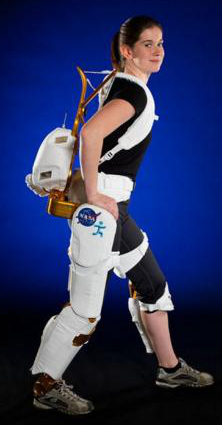 It took 17 days, but paraplegic Claire Lomas completed the 2012 London Marathon using robotic-assisted walking suit.
It took 17 days, but paraplegic Claire Lomas completed the 2012 London Marathon using robotic-assisted walking suit.
NASA is developing a more robust version of the robotic walker to assist astronauts, but the spin-offs here on Earth are plain to see. For those affected by Cerebral Palsy or those paralyzed in accidents, there’s the very real prospect they’ll walk again, if not through advancements in medical science to treat spinal defects and injuries then through the use of robotics. These robotic legs are an Iron Man suit without the rocket-propelled boots.
NASA’s X1 robotic exoskeleton could also be used to assist astronauts with muscular exercise in space, to help soldiers on the battlefield or to give Ripley something with which she can wrestle giant acid-dripping aliens.
Weighing in at 57 lbs or 25 kilos and supporting its own weight, the exoskeleton uses ten joints, four of which are powered, six of which are passive.
Another innovation, building upon research conducted over the past five years, is the ability of carbon nanotubes to repair damaged neural tissue. With strokes killing millions of people each year and paralysing millions more, the ability to repair damaged brain-tissue is an exciting development that has the potential to change countless lives for the better.
6: Self-driving cars are made legal in Nevada, Florida, and California
 Take a good look at your kids. Depending on their age, they may never learn to drive. Earlier this year, Google began testing driverless cars and three US states have past laws to let these cars roam free on their roads.
Take a good look at your kids. Depending on their age, they may never learn to drive. Earlier this year, Google began testing driverless cars and three US states have past laws to let these cars roam free on their roads.
With over 300,000 hours of autonomous driving under their belt, there’s been no accidents, at least, no robotic accidents. Ironically, the only time these driverless cars have been involved in an accident has been when humans have been at the wheel.
With an average of 90 deaths per day in the US attributed to motor vehicle accidents, and over 30,000 deaths per year, self-driving cars will make a significant impact on public health. Here in Australia, the annual road-toll has dropped from three thousand to just over a thousand deaths per year, but that’s still too much. Driverless cars will avoid a lot of heartache in the future.
Driverless cars are still several years away from production, but they’re on their way. Go Google!
5: Genetically-modified silk is stronger than steel
The phrase “genetically-modified” often evokes visions of a mutant monster and the prospect of food supplies being irrevocably damaged or destroyed. The truth, however, is rather different. Humans have been genetically modifying plants and animals for tens of thousands of years using artificial selection. Simply by breeding desirable traits we’ve developed dairy cows that radically overproduce upwards of 10,000 kg of milk per year, we’ve domesticated wolves and, over several thousand years, created Chiwawas and Great Danes, we’ve taken wild horses and bred them to be faster and lighter, to the point where their bones become so brittle they break easily under stress. None of these animals are in a natural state, they’ve all been modified by humans. And don’t get me started on chickens.
 Think of a natural food. What’s the most tasty “natural” food you can think of? Grapes? Bananas? Apples? They’re all clones, having been selectively bred to produce the best quality we’ve then cloned them to ensure the flavour is consistent from one apple to another, from one year to the next.
Think of a natural food. What’s the most tasty “natural” food you can think of? Grapes? Bananas? Apples? They’re all clones, having been selectively bred to produce the best quality we’ve then cloned them to ensure the flavour is consistent from one apple to another, from one year to the next.
Even produce like wheat and corn have been methodically and selectively bred over hundreds to thousands of years, transforming them from their “natural” state to one that is ideal for our nutrition.
With the advent of direct genetic modification, we can finally be deliberate and precise in the changes we desire within animals and plants. And the University of Wyoming has developed silkworms that produce (cross-species) spider-silk that is proportionately stronger than steel. This super-silk has a tremendous range of applications that could have a significant impact on our lives. Imagine the environmental impact of a biodegradable alternative to plastic that was stronger than steel. From surgical sutures, to lightweight body armour, there’s a whole host of possibilities.
There is a need to regulate genetically-modified plants and animals, but GM is not Pandora’s box, no more so than artificial selection ever was. When used in a scientifically robust and ethical manner, GM has tremendous potential to improve the quality of our lives.
4: Stem cells could extend life
Normally, mice live to about two years of age. Scientists at the Institute for Regenerative Medicine in Pittsburgh, Pennsylvania, studied mice with a genetic defect that caused them to ageing rapidly and die after 21 days. Using muscle stem cells from young, healthy mice, they were able to extend the life of these defective mice for over 70 days.
At first, researchers thought there was a mistake. Perhaps the samples had been mixed up and some healthy mice had been put in with the degenerative mice, but carefully controlled analysis showed they really had extended the lives of these genetically defective mice by a factor of three. If the same results were replicated with humans an eighty year old could reach two hundred years of age.
 As with so much scientific research, there were unexpected points of learning along the way. At first, the assumption was that the new, healthy stem cells had repaired internal organs, but scientists introduce a genetic marker into the healthy stem cells and were surprised to find very few of these stem cells made their way into the internal organs of the defective mice. If the healthy stem cells hadn’t extended the lives of these mice then what had?
As with so much scientific research, there were unexpected points of learning along the way. At first, the assumption was that the new, healthy stem cells had repaired internal organs, but scientists introduce a genetic marker into the healthy stem cells and were surprised to find very few of these stem cells made their way into the internal organs of the defective mice. If the healthy stem cells hadn’t extended the lives of these mice then what had?
Curious, scientists divided a flask in two with a membrane designed to keep cells apart. They introduced healthy stem cells in one half of the flask, and defective, rapidly ageing stem cells into the other. To their surprise, within days, the older, ageing cells began behaving “younger,” dividing more often. From this, scientists concluded that the younger stem cells were secreting a protein the older ageing cells could use to become renewed.
Stem cell therapy is still in its infancy, and this research was only conducted on muscle stem cells. There’s a long way to go before this could become a medical treatment, but the possibility of using proteins to tease the body’s own stem cells into regenerative behaviour is no longer science fiction.
3: Chimera monkeys created from multiple embryos
 Like something from a Frankenstein movie, scientists have combined cells from six distinctly different different embryos into three baby monkeys, such a hybrid creature is known as a chimera.
Like something from a Frankenstein movie, scientists have combined cells from six distinctly different different embryos into three baby monkeys, such a hybrid creature is known as a chimera.
According to researchers, “The cells never fuse, but they stay together and work together to form tissues and organs… Assumptions about the way human embryos develop have always been based on the (chimera) mouse, but that’s a dangerous assumption (because humans are so different).“
Animals formed as chimeras are used to better understand the role of genes in embryonic development, but previously this study had been limited to mice. Having primate models will increase the possibility of applying any learning about their genetic development to humans.
2: DNA was photographed for the first time
In 1953 James Watson and Francis Crick first identified DNA as a complex, helical molecule, recognizing its role in carrying the genetic blueprint for life. Although x-ray diffraction revealed the now familiar double-helix shape, it would be almost sixty years before a single strand of DNA could be photographed.
 Since 1953, our knowledge has grown in how DNA works with proteins and other molecules like RNA to provide the foundation for all of life on Earth, but this knowledge has been based on theoretical models and carefully controlled experiments. Now, for the first time, we have the opportunity to actually watch as proteins interact with DNA, and that will reveal the inner workings of the biological cell in even greater detail.
Since 1953, our knowledge has grown in how DNA works with proteins and other molecules like RNA to provide the foundation for all of life on Earth, but this knowledge has been based on theoretical models and carefully controlled experiments. Now, for the first time, we have the opportunity to actually watch as proteins interact with DNA, and that will reveal the inner workings of the biological cell in even greater detail.
In science, knowledge is power. Accurate, precise knowledge gives us the power to harness the natural biological processes to our advantage. There’s still more work to be done, but this level of visibility into the working of DNA has significant implications for areas like cancer research, disease prevention, treating genetic defects, etc.
1: The Higgs-Boson particle was discovered
The Standard Model of particle physics is an oddity. It’s not widely loved, but since its inception in the 1960s the Standard Model has been highly successful at combining and explaining the fundamental forces of nature. With the exception of gravity, the Standard Model has provided a robust explanation of the quantum world upon which the universe is founded.
 All other particles described by the Standard Model have been seen in experiments, but the Higgs boson, first predicted in the 1960s, had never been seen until 2012.
All other particles described by the Standard Model have been seen in experiments, but the Higgs boson, first predicted in the 1960s, had never been seen until 2012.
In the jigsaw puzzle that is particle physics, the Higgs field provides all other particles with their mass, so finding the Higgs and confirming its role in particle physics is an outstanding achievement.
Although this discovery may seem somewhat esoteric, this new knowledge will have an impact on our world. A hundred years ago, cars looked like jalopies, biplanes struggled to get into the air, the average life expectancy for a man was around 47 and the leading cause of death was tuberculous. A hundred years ago, we thought there was just one galaxy, ours, now we know there are hundreds of billions of stars in hundreds of billions of galaxies spread throughout the universe. A hundred years ago, the prospect of standing on the Moon or flying by Jupiter and Saturn would have seemed fanciful, like wishing on fairies, but advances in scientific knowledge have made all this possible and have radically changed our world. Imagine where humanity will be a hundred years from now.
It’s been a big year in science, you can see more highlights on other scientific topics at io9
Happy New Year


December 23, 2012
Jack Schmitt’s Christmas Poem
An article from Vintage Space, by Amy Shira Teitel
Here’s Gene Cernan and Jack Schmitt (upside down) during Apollo 17′s 1972 mission. Credit: NASA
NASA didn’t give its Apollo astronauts too much free time during missions. Crews had to go through multi-stage checklists before any manoeuvre and had experiments to run during the three day transits to and from the Moon. Everything, down to meal times and sleep periods, was scheduled. But as Apollo 17’s Lunar Module Pilot Jack Schmitt found out, you can’t schedule poetic inspiration. Even when you’re on the Moon.
Schmitt joined NASA’s astronaut corps in June 1965 as one of six scientist-astronauts. A former U.S. Geological Survey astrogeologist, he was among those that trained moonwalkers to recognize the right kinds of rocks worth bringing home from the Moon. And while he stands out among Apollo-era astronauts as the only scientist to fly a lunar mission, he almost didn’t make it. Schmitt entered the flight rotation as the backup LMP on Apollo 15, which secured him a spot for the prime crew of Apollo 18. Then 18 was cancelled in 1970. But NASA opted to give the scientist a crack at the Moon. The agency was by then planning its “J” missions that ostensibly had science at the core. Schmitt replaced Joe Engle on the prime crew of Apollo 17 and landed at Taurus-Littrow with Commander Gene Cernan on December 11, 1972.
 Here’s the orange soil Schmitt found during Apollo 17′s lunar surface activities. Credit: NASA
Here’s the orange soil Schmitt found during Apollo 17′s lunar surface activities. Credit: NASA
Cernan and Schmitt spent three days on the Moon, the longest of any Apollo mission. And they spent the longest time exploring the surface as well, a little of 22 hours during which time they collected more than 243 pounds of lunar samples. Schmitt’s keen geologist eye also famously discovered orange soil. Analysis on Earth revealed the orange material to be tiny spheres of coloured glass, typical of volcanic material release from a surface vent.
But Schmitt’s made other noteworthy contributions to Apollo 17. While on the Moon, he discovered he was a bit of a poet.
Late in the evening of December 14, 1972 (Houston time), Schmitt and Cernan woke up from their last sleep period on the Moon. After their landing, launch, and wake-up capcom Charles Gordon Fullerton – whom they alternatively called Gordo or Gordie – sung them awake, Schmitt did a little artistic performance of his own.
“Hey, Gordie,” Schmitt called to Houston. “In the tradition of Apollo 8, I’ve got paraphrase of a familiar poem for you.” And he read over the radio:
Well, it’s The week before Christmas and all through the LM, not a commander was stirring, not even Cernan. The samples were stowed in their places with care, in hopes that with you, they soon will be there. And Cernan – Gene in his hammock and I in my cap, had just settled our brains for a long – short lunar nap. But out on the – up on comm loop there rose such a scatter, I sprang from my hammock, to see what was the matter. The Sun on the breast of the surface below gave the luster of objects, as if in snow. And what to my wandering eyes should appear, but a miniature Rover and eight tiny reindeer. And a little old driver so lively and quick, I knew in a moment, it must be St. Nick. I heard him exclaim as he – over the hills he did speed. Merry Christmas to all and to all – to you all Godspeed.
 Here’s Schmitt, after the third and final EVA (and before tapping into his inner poet). Credit: NASA
Here’s Schmitt, after the third and final EVA (and before tapping into his inner poet). Credit: NASA
“Gordo,” said Cernan when Schmitt had finished, “that was the first time I heard that and I got to say – I got to say that is beautiful.”
“I agree,” replied Fullerton, then asked, “Did the LMP get any sleep or did he spend all night composing that?” He and Cernan did, after all, have a busy day ahead of them, including a rendezvous with Ron Evans in the Command Module and the beginning of their journey home. It wasn’t the best day to be tired.
Schmitt assured his commander and capcom that he had managed his usual 6 hours despite what he called his poetic inclinations. “People always said we ought to have a poet in space,” he added.
To which Cernan replied, “I don’t think we’ve made it yet.”


December 21, 2012
Mars or Bust
 As much as I would love to see someone standing on Mars, I’m worried about the cost, and not just the cost in terms of money or even in terms of human lives. For me, the greatest cost is the cost of lost opportunities elsewhere.
As much as I would love to see someone standing on Mars, I’m worried about the cost, and not just the cost in terms of money or even in terms of human lives. For me, the greatest cost is the cost of lost opportunities elsewhere.
The Apollo Moon landings were originally projected to cost $7 billion dollars but eventually came in at $25 billion dollars, which adjusts to several hundred billion dollars in today’s reckoning.
With half a million people working on the project over the course of a decade, Apollo is the modern equivalent of Stonehenge or the pyramids, it was a landmark in human progress. Apollo was a herculean effort, decades ahead of its time.
The Apollo program was a case of The Moon or Bust. The problem was, such an intense effort wasn’t economically sustainable in the long term. The 70s saw some tremendous space exploration, with the launch of Pioneer, Voyager and the Viking mission to Mars, but as remarkable as these were they were overshadowed by the mothballing of Apollo. Skylab salvaged some of the Apollo hardware from scrapped lunar missions, but plans for up thirty additional Apollo launches, covering everything from a manned fly-by of Venus to a lunar base were quietly shelved.
At the height of the Apollo project, NASA’s budget represented 4.4% of the US national budget. Since then, it has hovered between 0.5% and 1%. The US military, by comparison, consumes anywhere from 6%-9%, although when the books are balanced and all the receipts are talled this figure could be as high as 19%. A mission to Mars is thought to cost somewhere in the order of $20 billion dollars but given the experience with Apollo this is probably a gross underestimate, and there in lies the problem.
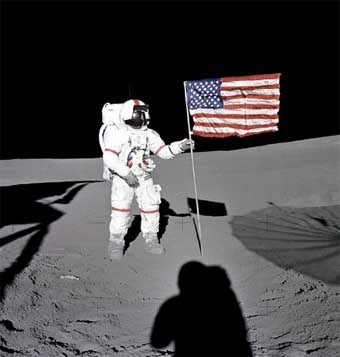 Mars or Bust is not an intelligent use of limited resources.
Mars or Bust is not an intelligent use of limited resources.
Human exploration is important, but exploration should be goal-driven, not driven by emotions.
Apollo’s goal was to demonstrate technical and economic superiority over the Soviet Union during the Cold War. Having been beaten to the punch with Sputnik and Yuri Gagarin, President Kennedy rallied a nation to salvage its pride. There were scientific outcomes, but these were secondary to planting a flag in lunar soil.
Space exploration needs goals with more substance than the fickle interest of public opinion as that will wax and wane.
The goal of exploring our solar system should be the search for extraterrestrial life, but not little green men, little green microbes.
It sounds silly when put like that, but the discovery of non-Earth-based lifeforms would be the single greatest discovery in the history of mankind.
Our lives are absurdly short. Here at the start of the 21st century we have so little appreciation of how far mankind has come even in just the last hundred years.
 A hundred years ago biplanes struggled into the air, cars like this 1912 Buick were little more than jalopies, the average life expectancy for a male was 47, the speed limit on roads in the US was 10 MPH and the leading causes of death were tuberculosis and influenza.
A hundred years ago biplanes struggled into the air, cars like this 1912 Buick were little more than jalopies, the average life expectancy for a male was 47, the speed limit on roads in the US was 10 MPH and the leading causes of death were tuberculosis and influenza.
A hundred years ago, we thought the only stars were those of our own galaxy, now we know there are hundreds of billions of galaxies each containing hundreds of billions of stars. Imagine what we’ll know a hundred years from now.
Our understanding of the universe is still in its infancy. We’ve only just begun to shed the Earth-centric myths that have dominated tradition and religion for tens of thousands of years. Ours is but a fleeting glimpse into a universe of astonishing possibilities.
To those that don’t think there’s life in outer space I have but one question, “Where the hell do you think we are?“
Of course there’s life in outer space, we’re living proof that life can abound in this harsh, hostile universe.
Is there any other life in outer space? Is there any other intelligent life in outer space? These are good questions. The answer is, we don’t know but we have no reason to think there isn’t.
It is important to note that there’s nothing we’ve discovered that would negate the possibility of life elsewhere. At each juncture we discover more possibilities for life to arise. Just this week, we discovered two planets in what’s considered the habitable zone around Ceti Tau a mere twelve light years away.
 There are good reasons to consider that there might be life elsewhere within our own solar system.
There are good reasons to consider that there might be life elsewhere within our own solar system.
My concern is a Mars or Bust mentality may push back the search for life on places like Enceladus, Europa and Titan by half a century. As it is, even without a manned Mars mission, there’s no serious plans for this kind of exploration within the next couple of decades.
My concern is the gargantuan effort to see footprints on Mars could jeopardise other projects that have a real chance of finding life.
When Cassini deployed the Huygens probe on Titan, one of the moons of Saturn, scientists were surprised by the absence of naturally occurring acetylene in the atmosphere and the low levels of hydrogen near the surface of the moon when hydrogen was abundant at other altitudes. Although further exploration is needed to confirm these observations, they are precisely what we’d expect to see if methane-based lifeforms were breathing/consuming hydrogen as part of their lifecycle!
Another moon of Saturn, Enceladus is throwing samples into space for us to examine at our leisure. Cassini flew through the fine ejecta from the geysers on Enceladus and detected a saltwater brine that include methane and propane and other carbon-rich molecules. With the right equipment, a fly-by of Enceladus could either analyse or return samples for analysis and reveal the possibile existence of life. Sure beats drilling through miles of ice.
 One of the molecules detected by Cassini in the Enceladus plume is Clathrate, a carbon molecule that performs an important role in biology here on Earth, trapping and containing other molecules and proteins.
One of the molecules detected by Cassini in the Enceladus plume is Clathrate, a carbon molecule that performs an important role in biology here on Earth, trapping and containing other molecules and proteins.
Ah… but Enceladus is just a moon, right?
Yes, Enceladus is smaller than our Moon and could fit inside Arizona but consider Europa, one of the moons of Jupiter.
Europa is another potential target in the search for life within our solar system.
There is more water on Europa than there is on Earth. In fact, there’s three times as much water on Europa as there is in all of Earth’s lakes and oceans.
We have limited resources when it comes to space exploration, we should use them wisely, where there is the greatest possibility for scientific breakthroughs.
Exploration should be goal-oriented. Our goal should be to find life and that means looking beyond Mars. We’ll get to Mars one day, but let’s not sacrifice good science on the way.
Let’s not make it Mars or Bust.


December 18, 2012
Muggle Magic
Disclaimer: I’m not a Harry Potter fan and I have not read any of the books written by J. K. Rolling, but I loved Harry Potter and the Methods of Rationality, a fan fiction novel written by Eliezer Yudkowsky.
 If you’ve seen the Harry Potter films and walked away frustrated with any of the various inconsistent, illogical aspects of these stories, then Harry Potter and the Methods of Rationality is for you.
If you’ve seen the Harry Potter films and walked away frustrated with any of the various inconsistent, illogical aspects of these stories, then Harry Potter and the Methods of Rationality is for you.
Without spoiling the story and giving too much away, I will say the storyline for the Methods of Rationality is far more plausible than anything J.K. Rolling ever came up with.
In essence, Harry is a young scientist trying to make sense of a topsy-turvy magical world. Harry struggles with the repugnant possibility of becoming the next Dark Lord and is determined to apply scientific method to the subject of magic in order to make the world a better place.
Remember the scene from the movie where Professor McGonagall turns into a cat and then back into a person? Scientific Harry realizes there are serious problems with this magic trick.
You turned into a cat… You violated the Conservation of Energy! That’s not an arbitrary rule, it’s implied by the form of the quantum Hamiltonian… And cats are COMPLICATED! A human mind can’t just visualize a whole cat’s anatomy, and, and all the cat biochemistry, and what about the neurology? How can you go on thinking using a cat-sized brain?
And as for Qudditch… Well, Harry sums up my thoughts about this absurd fictional sport.
“So let me get this straight… Catching the Snitch is worth one hundred and fifty points? … How many ten point goals does does one side usually score, not counting the Snitch?”
“Um, maybe fifteen or twenty in professional games,” Ron replied.
“…That violates every possible rule of game design… you’re basically saying that catching the Snitch overwhelms almost any ordinary point spread… [it] makes everyone else’s work moot. It’s like someone took a real game and grafted on this pointless extra position so that you could be the Most Important Player without needing to really get involved or learn the rest of the game. Who was the first Seeker, the King’s idiot son?”
But the real beauty of this book is the respect it shows for science.
Professor McGonagall… seemed to have never heard of the scientific method. To her it was just Muggle magic…
And trying lots of different ways to do something isn’t the same as experimenting to figure out the rules. There were plenty of people who’d tried to invent flying machines by trying out lots of things-with-wings, but only the Wright Brothers had built a wind tunnel to measure lift…
And that strikes at the heart of a fundamental fallacy that is common in the media, that science is just trying stuff out. Science, it seems, is Muggle magic to most people.
 Earlier this evening, I watched a medical doctor on TV talking about how some medicines can be applied to different purposes. He said it was “exciting” to “try different medicines with different patients to see what works,” and I cringed at his appalling disregard for the scientific method.
Earlier this evening, I watched a medical doctor on TV talking about how some medicines can be applied to different purposes. He said it was “exciting” to “try different medicines with different patients to see what works,” and I cringed at his appalling disregard for the scientific method.
Can you imagine the heartache and misery that would be caused if this was the approach we took to medicine? You might as well try ingredients from a magic potion, like bats wings and newt tails. At least with them you’d cause less damage.
Emerging medicines go through years of peer-reviewed study before they get to double-blind efficacy trials and a new medicine becomes available, anything less would be grossly irresponsible. And although this is a slow and arduous approach, it’s a lot better for you than buying snake oil from some zealot on a street corner.
I don’t think this doctor intended his comment to come out quite the way it did, and most people would have missed the implication, that science is just poking around in the dark with a stick, but this kind of misrepresentation is damaging. Harry Potter and the Methods of Rationality goes a long way toward correcting this cultural imbalance.
How about this for thought provoking?
…the most fundamental question of rationality: Why do you believe what you believe?
And as for science, our wonderful Muggle magic…
What you understand, you can command, and this is power enough to walk upon the moon…
If you’re looking for some light, entertaining reading over the holidays, grab yourself a copy of Harry Potter and the Methods of Rationality as a free eBook.


December 11, 2012
The drought has ended
I don’t know why, but the appearance of great science fiction movies is somehow cyclical. You get a few classics, then for years there’s nothing but a run of B-grade wannabes and remakes. Finally, Hollywood wakes up and stops churning out trash-for-a-buck and backs some original science fiction again, respecting a discerning audience, and the drought breaks.
I don’t hold high hopes for Star Trek Into Darkness. I’m sure it will contain some great space opera, but the last Star Trek was a travesty of science fiction. A journey from Earth to Vulcan took minutes, while the return journey took days! Characters teleported onto ships travelling at warp speed and, presumably, light years away, only to materialize inside water-filled cooling tubes(?) and – oh, don’t get me started.
At first glance, Oblivion and After Earth are entirely different, marking a return to classic science fiction movies that stir the imagination. They’re both quasi-plausible future visions of a dystopian Earth. Not only do they look great in terms of special effects, they’re exploring new territory in their story arcs, which is always refreshing, and they appear more grounded around solid characters.
Oblivion
After Earth
I’m looking forward to both of these films. I’m sure there will be the odd technical fubar, but hopefully nothing on the scale of Star Trek or Prometheus. It would be nice to see another classic emerge from Hollywood.


December 10, 2012
Free falling
 Think of the International Space Station and images of astronauts floating around in zero gravity spring to mind, and yet such images are misleading.
Think of the International Space Station and images of astronauts floating around in zero gravity spring to mind, and yet such images are misleading.
Whether it’s a space walk or conducting experiments with bubbles of water floating within the confines of the station, we assume astronauts are not subject to gravity in the same way as we are, and yet nothing could be further from the truth.
Gravity is all the more remarkable for the fact that it seems pretty straight forward and yet we don’t entirely understand it.
Einstein thought of gravity as a consequence of mass distorting space-time. Modern thinking describes it using quantum force/particles called gravitons which are, at this point, undiscovered. Picture a bunch of springs pulling things together and you get a simple illustration of how gravitons are thought to work.
I’ve had a great yarn with a physicist and amateur astronomer in Garland, Texas on this subject. I’m a little old school, seeing the influence of mass on both space and time as evidence for gravity being a consequence rather than a force, but he’s got some persuasive arguments for the unification of relativity and quantum mechanics that would treat gravity as a quantum force like the nuclear forces. Certainly, the discovery of the Higgs Boson tends toward this conclusion. If you ever happen to be driving through Garland, Texas, stop off at the Firewheel Coffee house and enjoy the debate over a cup of the best coffee this side of Andromeda.
Why’s it such a big deal? Gravity is the last physical phenomenon to be incorporated into what’s known as the Standard Model, an equation for everything.
 For some, the notion of an equation “for everything,” might seem a little grandiose and perhaps even arrogant and egotistical, after all, what about love, or art and culture? But these are emergent properties that can only exist because of the physical world around us.
For some, the notion of an equation “for everything,” might seem a little grandiose and perhaps even arrogant and egotistical, after all, what about love, or art and culture? But these are emergent properties that can only exist because of the physical world around us.
Once gravity is incorporated into the Standard Model, or the Standard Model is extended by concepts such as String Theory, we will have an accurate understanding of the universe, something that can be articulated in a concise manner.
Why is this important? The technology we use is possible only because we’re harnessing the natural laws of the universe. The flight of a plane, the workings of an MRI scanner or the computer you’re looking at right now are all extensions of our understand of these laws. Gaining a theoretical mastery of unified physics will extend our technological reach even further.
Gravity, though, has remained elusive, even though we understand its effects extremely well. Getting back to the opening point, there is no zero gravity. Whenever you see someone floating in space you’re seeing someone moving with a constant velocity that counteracts the attraction of gravity. As this may seem counterintuitive an explanation might help.
 Newton was the first scientist to think about the implications of firing cannonballs further and further. He realized Earth was curved and so as his imaginary cannonballs flew further and further he realized the planet would drop away beneath them.
Newton was the first scientist to think about the implications of firing cannonballs further and further. He realized Earth was curved and so as his imaginary cannonballs flew further and further he realized the planet would drop away beneath them.
Eventually, if enough force was applied, Newton realized his cannonball would be travelling so fast that, as it fell, Earth would curve away beneath it and it would never hit the ground. This was a startling insight, and is the basis behind our modern satellites.
But notice that the cannonball is not in zero gravity. In fact, the reason it is curving as it orbits Earth is precisely because of gravity. If there were no gravity, the cannonball would sail off in a straight line.
Galileo realized all objects are under the same influence of gravity and so will fall at the same rate, only air resistance slows them down. During the Apollo 15 Moon landing, Commander David Scott dropped a hammer and a feather on the Moon and they both struck the Lunar surface at the same time confirming, Galileo’s assertion. Mythbusters replicated this by dropping a hammer and a feather in a vacuum chamber.
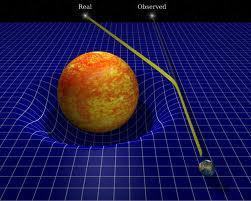 Einstein took things one step further. Realizing mass and energy were equivalents he realized light too would be subject to gravity.
Einstein took things one step further. Realizing mass and energy were equivalents he realized light too would be subject to gravity.
Here’s an experiment you can’t try at home, simply because Earth isn’t big enough, but if you took a laser pointer, pointed it horizontally so the light is going to travel parallel with the ground, and then fired it at the same time you dropped a rock, both the rock and your beam of light would strike the ground at exactly the same time (only millions of miles apart).
Earth would have to be pretty darn big to conduct this experiment, but the point is, gravity affects everything equally, even light, only light moves so fast it quickly moves beyond large gravitational masses like Earth so the effect is small.
Rather than traveling in straight lines, light zigs and zags through space as it passes through various gravitational fields, bending and twisting in extraordinary ways. If light from a distant galaxy passes close to another galaxy on its way to us, it can bend and twist around the intervening galaxy, allow us to see multiple images of the distant galaxy so far, far away. This effect is known as gravitational lensing.
 Light from these distant galaxies distorts like the crazy house of mirrors at the county fair. If the same effect occurred on terrestrial scales, you’d be able to stand in the shadow of one house and still see the house directly behind it, only the second house would be curved and compressed around your home.
Light from these distant galaxies distorts like the crazy house of mirrors at the county fair. If the same effect occurred on terrestrial scales, you’d be able to stand in the shadow of one house and still see the house directly behind it, only the second house would be curved and compressed around your home.
In this image, we get several stretched out, distorted images of the same (blue) galaxy hidden behind the (yellow) quasar in the foreground.
Getting back to our intrepid astronauts floating “in zero gravity” it’s important to note that “zero gravity” doesn’t occur anywhere in the universe.
If we could build a tower that reached up to the same height as the space station, some 370km above Earth, would we too float like the astronauts?
The answer is, no.
Standing atop our impossibly tall tower we would feel less gravity than we do at sea level, but we wouldn’t float away. Drop a hammer and it will fall at 8.8 meters per second squared instead of 9.8 meters per second squared down near the ground. And, every hour and a half, we’d see the space station go whizzing by considerably faster than a bullet. Blink and you’ll miss it entirely, as the space station is moving at over 10,000 miles an hour, or roughly three miles a second.
Images from the space station, though, would look serene. Astronauts would float gently beside the station, moving slowly about their tasks. Inside the station, astronauts would drift casually through the cabin, blissfully unaware of their breakneck speed as they whiz by our tower. They’ve been falling for soooo long without hitting anything they’ve become accustom to the weightless experience of constantly falling.
 The space station is in free fall around a very massive object, Earth. Ride on a roller-coaster, take a airplane flight through a turbulent storm, or jump on a trampoline and you’ll experience the same sense of weightless free fall, although only for a second or so.
The space station is in free fall around a very massive object, Earth. Ride on a roller-coaster, take a airplane flight through a turbulent storm, or jump on a trampoline and you’ll experience the same sense of weightless free fall, although only for a second or so.
Gravity is pervasive. Right now, your body is experiencing the gravitational pull of Earth, the Sun and the Moon, along with all the planets, stars and galaxies spread throughout the entire universe.
If someone walks into a room or walks up to a large building, though, they’re subtly feeling a greater sense of gravitational attraction from these objects than from any of the planets. Gravity is plastic, it ebbs and swells like waves on the ocean as you approach any mass of any size.
The point of all this is that there is no “zero gravity,” but there’s plenty of fast moving objects in free fall around a large mass, you’re on one right now as Earth falls around the Sun and the Sun falls around the Milky Way, and on it goes.








